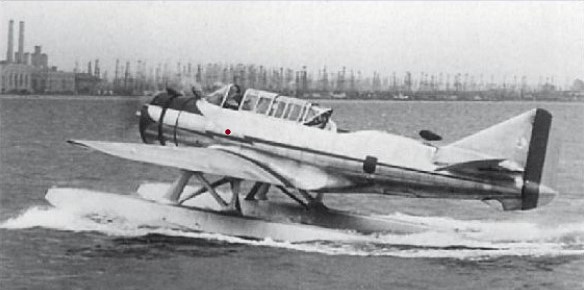BRAZILIAN AIR FORCE FAB * - BRAZILIAN AIR FORCE
30)VULTEE V11 GB 2
Total received:26
Characteristics:
Performance: Maximum speed: 200 knots (230 mph, 370 km/h)
Range: 1,174 NM (1,350 mi, 2,174 km) ferry range
Service ceiling: 20,500 ft (6,250 m)4 x forwards-firing .30 calibre machine guns, 1 x aft-firing .30 calibre machine gun
Length: 37 ft 10 in (11.53 m).Wingspan: 50 ft 0 in (15.24 m). Height: 10 ft 0 in (3.05 m)
Max takeoff weight: 10,420 lb (4,736 kg)
Powerplant: 1× Pratt & Whitney R-1830-17 Twin Wasp 14 cylinder two row radial, 1200 hp (895 kW)
Armament: 1 x ventral .30 calibre machine gun, 1,080 lbs bombs in internal bay.
Crew: Three
The first V 11 GB2 were brought to Brazil by ship, being assembled in the hangar of Panair do Brasil, located at Santos Dumont Airport (Rio de Janeiro), the rest being assembled at the Aeronautical Central Park, which delivered them, on June 5, 1939. The V-11GB2 received serial registrations 105 to 129, and this system was maintained throughout its operation in the Brazilian Army until 1941. As soon as they were incorporated, the aircraft were destined to the 1st Aviation Regiment (1ºRAv), being alloted in the Bombardment Group, with the first operational flights occurring in the first week of November 1938. In September 1939 three units were transferred to the 3rd Aviation Regiment (3rd RA), based in Porto Alegre (RS). The Military Aviation School (EAvM), based in Campo dos Afonsos, received on April 13, 1939 three V-11s for the purpose of training the instructors and cadets of the last year.
The changes requested by the Army Military Aviation Directorate made the V-11GB2 perform slightly lower than the V-11GB in terms of maximum speed, climb rate and operating ceiling, but they had a significantly larger range than can be gauged in one of the most remarkable accomplishments in Brazilian military aviation, being responsible for establishing the flight record and distance when completing a nonstop flight lasting 11:45 hours between Fortaleza and Canoas one small Air Base on 8 July 1939. This operation profile encouraged the DAVM to increase the number of aircraft, adding another five units to the original contract, which were configured with dual controls for the instructional tasks. In addition the manufacturer developed a version with floats called V-11GB2F which was intended for a possible purchase by naval aviation, with the construction of a prototype that eventually came incorporated into the Army Aviation.
With the creation of the Brazilian Air Force on January 27, 1941, the remaining 23 cells were incorporated into the roster of this new force, temporarily maintaining their original Military Aviation markings, thus applying the new markings including the adoption of 4-digit serial plates . The need to increase patrolling missions on the Northeastern coast forced the displacement of six V-11GB2 from the 1st RA to Recife, where they were employed in this task from October 1941 to May 1942, when they were replaced by suitable aircraft for this type of mission. On April 17, 1945, three aircraft were transferred from the 1st RA to the 3rd RA, with the objective of reinforcing patrol activities on the southern coast of Brazil.
By http://www.armasnacionais.com

In 26 Aug 42, an attack was made against an enemy submarine 50 miles off the town of Ararangua in the State of Santa Catarina, southern Brazil. It was the ony action undertaken by one Brazilian aircraft south of Rio de Janeiro. Despite the unsuitability for anti submarine operations, the tiny aircraft and its crew led by Lieutenant Alfredo Correa dived very low dropping their load of 3 demolition bombs with 250 lbs each which exploded around the sub. A huge column of water and debris engulfed the aircraft which flew a few feet above the waves hitting the engine cowling thus making the flight of the single engine Vultee a very risky one.
With engine failure and oil pressure quivering the valiant crew headed the continent and made a safe landing at the town of Ozorio. The fact showed the high degree of preparedness and resolve of an Air Force created in December 1941. Brazilian Air Force crewmembers notwithstanding the lack of appropriate anti submarine aircrafts in the early stages of the war flew their missions over the vast expanses of the south Atlantic with great courage and patriotism.
Artistic rendition depicts the attack on an enemy U-boat off Ararangua State of Santa Catarina.
View of a Vultee V 11 squadron in patrol sweep over the south Atlantic.
This particular aircraft was modified to fit a pair of EDO floating devices, once the same was ordered by the Brazilian Navy. This type of modification in form of one kit, had already been passed on trials in GB models exported to Russia (re designated as GBS and GBF). Besides the incorporation of these floating devices, the aircraft also had the tail modified to improve lateral stability. It was designated GB2F. Nevertheless, the same did not pass under the tests conducted by the Brazilian Navy and was incorporated by the Army Air Force.

One entire Vultee Squadron seen at Afonsos Field. Brazilian Air Force employed all means to counter the submarine menace in our coast.
Brazilian pilots seen gathered in front one V-11. They flew long patrol sweeps over the south Atlantic when Brazilian Air Force had not yet received more suited twin engines for ASW operations.
The photo shows several Vultee V11 aligned at Afonsos Field Rio de Janeiro the craddle of the Brazilian Air Force. Picture by FGV-CPDOC









